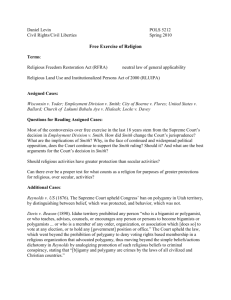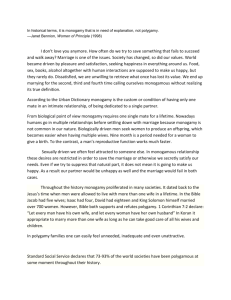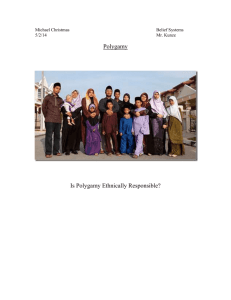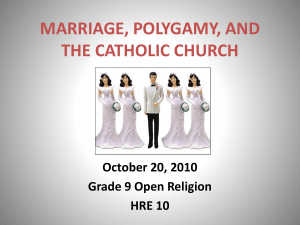A Cruel Arithmetic: Inside the Case Against Polygamy
advertisement
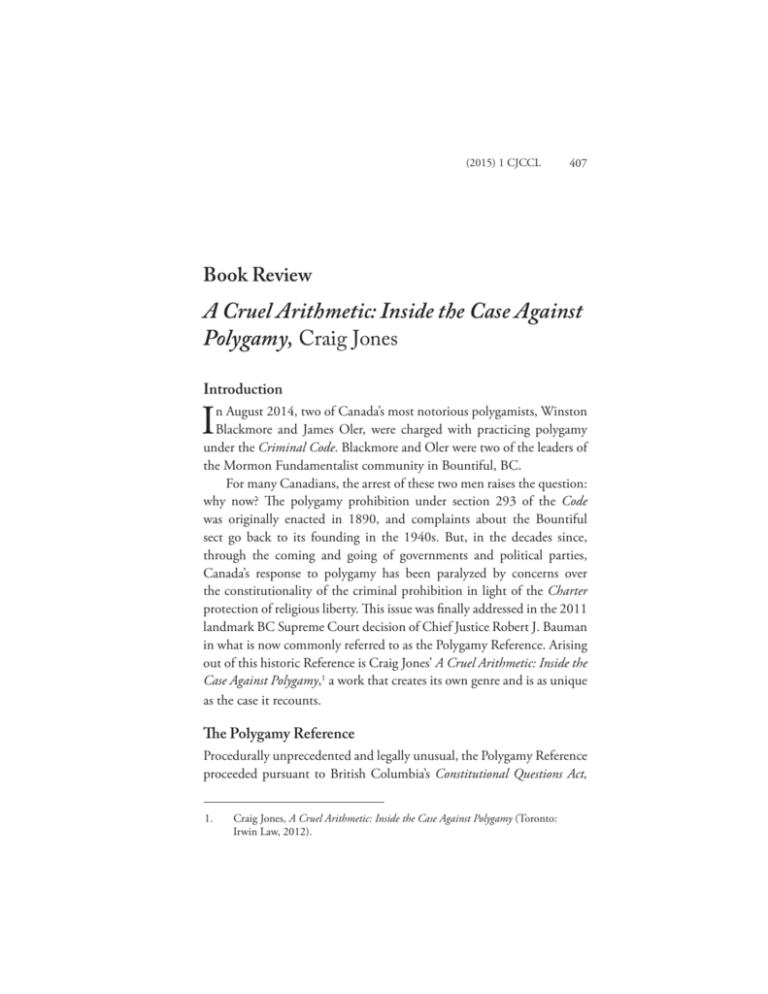
(2015) 1 CJCCL 407 Book Review A Cruel Arithmetic: Inside the Case Against Polygamy, Craig Jones Introduction I n August 2014, two of Canada’s most notorious polygamists, Winston Blackmore and James Oler, were charged with practicing polygamy under the Criminal Code. Blackmore and Oler were two of the leaders of the Mormon Fundamentalist community in Bountiful, BC. For many Canadians, the arrest of these two men raises the question: why now? The polygamy prohibition under section 293 of the Code was originally enacted in 1890, and complaints about the Bountiful sect go back to its founding in the 1940s. But, in the decades since, through the coming and going of governments and political parties, Canada’s response to polygamy has been paralyzed by concerns over the constitutionality of the criminal prohibition in light of the Charter protection of religious liberty. This issue was finally addressed in the 2011 landmark BC Supreme Court decision of Chief Justice Robert J. Bauman in what is now commonly referred to as the Polygamy Reference. Arising out of this historic Reference is Craig Jones’ A Cruel Arithmetic: Inside the Case Against Polygamy,1 a work that creates its own genre and is as unique as the case it recounts. The Polygamy Reference Procedurally unprecedented and legally unusual, the Polygamy Reference proceeded pursuant to British Columbia’s Constitutional Questions Act, 1. Craig Jones, A Cruel Arithmetic: Inside the Case Against Polygamy (Toronto: Irwin Law, 2012). 408 Book Review which allows for references to the BC Supreme Court. The idea of a reference had been initially rejected because such proceedings customarily take place before the Supreme Court of Canada or a provincial Court of Appeal, where arguments are heard in factual vacuums, precluding the opportunity to develop an evidentiary foundation. Both personal and expert evidence about polygamy and its harms was something that senior counsel, Leonard Doust QC and Richard Peck QC, had deemed crucial if the section 293 prohibition was to endure in the face of apparent interference with the Charter rights and freedoms of its participants. The trial court reference would be the first of its kind, with Jones leading a dedicated and talented team of lawyers from the provincial Attorney General, working alongside lawyers from the federal Department of Justice. George McIntosh QC (now a Supreme Court Justice) was appointed as amicus curaie to litigate the opposing position. A Book As Unique as the Case it Recounts The book that emerged from the Polygamy Reference is both a historical and philosophical exposition, and a trial diary interwoven with a memoir of personal recollections and observations. From lighthearted exchanges between opposing counsel and impromptu meetings with the disarmingly personable former Attorney General Wally Oppal (whose finger found its way to Jones’ chest on at least one occasion) the author depicts the human side of high-profile, public interest litigation. The Comprehensive Theory A Cruel Arithmetic challenges the default position of most who would seek to champion civil liberties by viewing polygamy as a practice between consenting adults with which others should not interfere. Jones explains that he understands this position because it was his own. He describes the way in which his perception of polygamy, which was characterized by a deep and profound ambivalence, changed dramatically. It was evidence of the harms of polygamy, both to its participants and to society at large, that challenged his laissez-faire instincts and caused him to conclude that it was not enough to target the visible abuses stemming from polygamy while ignoring the practice itself. (2015) 1 CJCCL 409 The author’s shift in thinking happened over time, but there is one moment of realization that Jones cites as being just short of Damascene. The epiphany occurred when he came across the phrase “the cruel arithmetic of polygamy” in Daphne Bramham’s book about Bountiful, The Secret Lives of Saints.2 Bramham’s phrase referred to the fact that polygamous communities create pools of unmarried men (‘lost boys’ in Bramham’s parlance) who are vulnerable to exploitation and abuse. Insular religious communities then find ways to “dispose of ” surplus males, who present a threat to those who wish to acquire more wives. Jones’ realization was that, child brides, the other problem frequently associated with polygamy, was also an inevitable result of the “cruel arithmetic”. In order to sustain the demand for more wives than the existing pool of women can satisfy, men in polygamous communities must recruit from the ranks of younger and younger girls. In this way, the culture of pedophilia, endemic in polygamist sects, cannot be separately addressed because it is a necessary feature of the culture. “Bountiful did not invent polygamy”, Jones writes, “polygamy invented Bountiful.” This understanding formed the Attorney General of BC’s comprehensive theory of polygamy upon which all of its resultant harms were demonstrated to be the inevitable explanation, rather than merely a sensible hypothesis. To organize the evidence in support of this theory, the government lawyers divided their tasks with Jones overseeing expert evidence while other members of his team searched for eyewitnesses, including a number of ‘survivors’ of polygamous communities. These compelling testimonies were presented, in large part, through the device of video affidavits, which were used to breathe life into witnesses’ testimonies and allow the court an extra level of proximity to the personal, lived realities of those caught in polygamy’s wake. The Overwhelming Evidence Some of the witnesses appeared in court to give live testimony, and the author provides brief vignettes detailing their examinations. One particularly moving example comes from the direct questioning of 2. Daphne Bramham, The Secret Lives of Saints (Toronto: Vintage Canada, 2008). 410 Book Review Truman Oler, the estranged brother of Bishop James Oler. Jones describes Oler speaking in a slow and halting fashion, pausing for half a minute at times before answering a question. His answers told the story of relational and emotional brokenness, rejection, and of a profound, enduring pain, the effects of which have rippled into his adult life. As Truman spoke, the gallery sat frozen in weighted silence. Jones recalls that a CBC report later referred to Oler’s testimony as “unbelievably powerful.” In contrast, the expert evidence explained and rationalized the emotional eyewitness testimony in academic and sometimes empirical terms. According to Jones, the most compelling expert evidence, as reflected in the decision itself, came from Dr. Joe Henrich. This evidence showed causation of polygamy’s harms rather than mere correlation. On the stand, Dr. Henrich hypothesized that polygamy is the ready response of human psychology and if it were decriminalized, Canada might become a destination for polygamous families who wish to live without fear of the law. Further, because polygamous families have children at a dramatically higher rate, these communities would expand faster than their monogamous counterparts. And, given that within our society high-status men often divorce an older wife to marry someone younger, polygamy might create a more convenient alternative for men, especially those who wish to remain under the same roof as their children. Finally, Dr. Henrich presented a lighthearted, but nevertheless startling anecdote. He explained that when he teaches evolutionary psychology at UBC, he issues “clickers” to all of his students. He then asks the female students to consider a scenario. “You’re in love with two men”, he states. “One is a billionaire, he already has one wife and he wants you to be his second wife.”3 Dr. Henrich then asks female students to imagine they are equally in love with a regular, unmarried man, who is not a billionaire but identical in every other way. According to Dr. Henrich, about 70 percent of his female UBC undergraduate students choose the billionaire. In this way, Dr. Henrich explained that it is not ridiculous to think that polygamy could spread to non-trivial levels, even in a modern liberal democracy like Canada, if permitted. 3. Reference re: Section 293 of the Criminal Code of Canada, 2011 BCSC 1588, [2011] BCJ No 2211 (QL) at 555. (2015) 1 CJCCL 411 The personal and expert evidence of the Attorney General demonstrated an extraordinary level of convergence. This feature did not escape Chief Justice Bauman who stated in his decision that, “from high level predictions based on human evolutionary psychology, to the recurring harms identified in intra-cultural and cross-cultural studies, to the “on the ground” evidence of [polygamy] in contemporary North America… [the] convergence becomes increasingly striking.”4 In addition to direct evidence, Jones’ meticulous cross-examinations demonstrate that even the most competent expert witnesses may come undone on the stand where their footnotes reveal imprecise research. The Decision The Court released its decision on November 23, 2011 and arranged for a ‘lockup’, which is an uncommon procedure whereby the parties and the media are given permission to read a decision in specially designated rooms before it is made public. With much anticipation, the government lawyers waited in their assigned room in the basement of the courthouse. Finally, the voluminous 357-page decision was placed before them. Only having an hour and a half of reading time, they quickly flipped to the back to learn they had won, and, as the pages flipped forward, they soon realized they had won convincingly. Their evidence was referred to as “overwhelming” and their singular theory of polygamy and its harms was broadly adopted with almost wholesale endorsement. When Jones left the room, he called Victoria to relay the news; his report was met with an uproar of cheers as well as the effusive personal congratulations of the Attorney General, Shirley Bond. Commentary A Cruel Arithmetic has a literary quality, which, when combined with the simplicity and clarity of the writing style, almost camouflages the sophistication of its content. Judiciously-placed literary flourishes illustrate the Reference courtroom as an ocean of black wool and silk, humming with muted excitement, silenced only by the entrance of a 4. Ibid at 492. 412 Book Review clerk and a call to order. While containing the educational value of a textbook in constitutional law, advocacy, and civil procedure, literary techniques contribute to a reading experience where the vast amount of information learned by the reader seems incidental, a byproduct of an enjoyable read. A Cruel Arithmetic is also deeply philosophical, grappling with the essence of what it means to be human, the nature of causation itself, and the way we organize the most intimate, and perhaps even sacred, aspects of our lives. Jones challenges those with a tendency to perceive their natural discomfort with polygamy as a manifestation of cultural imperialism, prejudice, or intolerance. He convincingly argues that this thinking has clouded our ability to form a sincere concern for the boys who have been discarded by their communities and the young girls who have been indoctrinated to believe that their purpose is to fulfill the desires of old, powerful men who trade them like collectibles. Implications On August 27, 2014 a federal judge in Utah issued a final ruling striking down a part of the state’s polygamy ban as unconstitutional. In response to the decision, Marci Hamilton, a professor at the Cardozo School of Law made the surprising statement that, “Partly, Utah is to blame because they did a lousy job of presenting the evidence of the effects of polygamy and the way that the system operates.”5 This observation does more than cast that case in sharp relief to the work done by the Attorney General of BC in the Polygamy Reference, it also highlights the far-reaching implications of the team’s combined efforts. Our Canadian legal landscape might look quite different but for the 2011 case. As for Blackmore and Oler and the future of polygamy in BC, Craig Jones concludes A Cruel Arithmetic by stating, perhaps presciently: Of what consequence are Blackmore and Oler to the progressive development of rights in Canada? They can exploit individuals, but, as 5. Amanda Holpuch, “Utah Judge Strikes Down Part of State’s Polygamy Ban in Sister Wives Ruling”, Editorial, The Guardian (28 August 2014) online: The Guardian <http://www.theguardian.com/world/2014/aug/28/ utah-strikes-down-polygamy-ban-sister-wives>. (2015) 1 CJCCL 413 the reference decision showed, society will not tolerate them forever, and they will eventually be swept aside. Anne Cochrane
